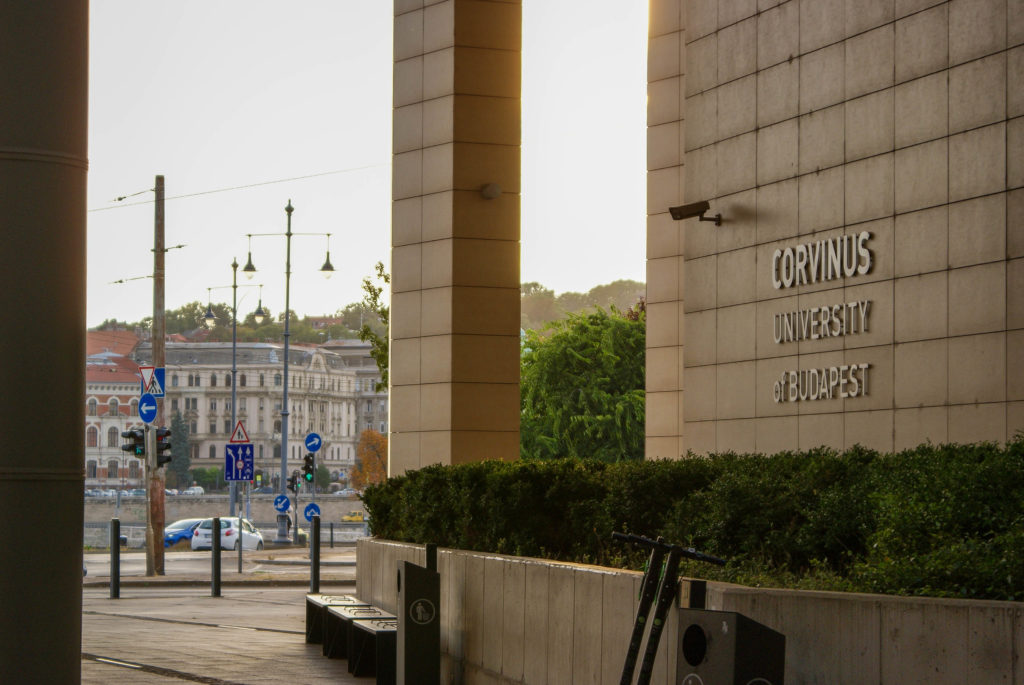A New Horizon of Accessibility – How Corvinus Helps Students with Disabilities
Corvinus has adopted a new, holistic approach to disability policy. The change of approach, which concerns all university citizens, also covers social responsibility and sustainability. Jácint Farkas talked to us about what this holistic approach means and why it is important, and how accessibility relates to responsibility and sustainability.
06.10.2021 Written by: Lili Szentkirályi, cover photo: Benjámin Kristóf, Economist

Accessibility does not merely highlight members of a specific group, who are not beyond a glass wall, inaccessible: this glass wall is permeable, can be studied and removable.
Before and after the disability policy
The University has, according to Jácint Farkas, adopted an game changing proposal with the launch of the new Accessibility and Disability Policy. Unlike before, the new policy covers a much broader spectrum in highlighting the need for accessibility, bringing new groups, such as those in need of mental health support or foreign students, under the umbrella of those in need of support, in addition to the usual traditionally affected parties.

“If we only had this ‘plain’ institutional disability policy, we might consider students with disabilities in a more segregated and specialised way,” – says Jácint, who is the former president of the Doctoral Student Union, a researcher at the Corvinus Institute for Advanced Studies and one of the professional coordinators of the Ethics, Responsibility and Sustainability (ERS) HUB, which is being set up at the university.
The other pillar of the holistic approach is to ensure that disability is not just a university task to be ticked off, but that it brings real change that is integral to the organisation and functioning of the university. Accessibility must be understood as going beyond the ‘physical’ and technical assistance-focused requirements of the relevant legislation.
We believe that, in addition to classic accessibility, the whole university should embrace the spirit of accessibility. The aim is not to create a barrier-free bubble over the university, or to create a cotton-padded university, but to prepare students for real life, says Jácint.
Corvinus had such a regulatory framework, but according to Jácint it was average. Various accessibility ‘practices’ have been and are still in place, such as assistance in obtaining special textbooks for students with dyslexia and dysgraphia, or extra time for writing tests and taking exams. There is a Disability Committee (Hungarian abbreviation: ‘FOB’) which works with the university’s specialist staff to help people with disabilities have a better chance of completing their studies.
What is considered a difficulty?
This of course raises the question of what counts as a difficulty exceeding the average. A great example of this is the final exam: a task that is demanding and difficult for everyone. However, there is a limit beyond which the student is no longer able to overcome the obstacle using their own ‘resources’, whether mental or physical, and that is when help should be introduced.
This limit varies from person to person. The rule is that help can be sought for medically verified difficulties, but as these are individual and personal matters, help may be required regardless. A concrete example is when someone is having problems with oral exams, they have the option to change the oral exam to a written exam. According to Jácint, accessibility does not mean that students are exempt from all obstacles. The university provides accessibility where it can and helps students to see obstacles as opportunities.
“In an inclusive university with an accessibility approach, we don’t exempt students from the requirements, but we create a pool of opportunities to help those who, beyond the general difficulties, may at first glance find it difficult to pass an exam, for example,” – says Jácint.

Who is considered affected and who decides who is affected?
The above raises the question of what determines whether someone is eligible for these forms of assistance. As already mentioned, certain conditions can be professionally justified, and the FOB provides the appropriate background. The policy also aims to make the FOB more ‘personalised’ and to broaden the framework to ensure that all kinds of difficulties (whether physical, mental or psychological) can be handled in the appropriate way.
This, of course, involves promoting the aforementioned accessibility approach among students, which means both awareness of the FOB and the perception of obstacles as opportunities. This is also important because it breaks down the wall between the two groups (those who need accessibility and those who do not) and, on the other hand, there is often a crossover, even temporary, between the two groups.
If a student finds themselves in a situation where they require accessibility, it is important that they know that they can find their place among students with special needs and receive assistance,” – says Jácint.
In addition to the difficulties traditionally associated with accessibility (e.g. physical difficulties – mobility, visual, hearing, etc.), it is also important to pay attention to psychological difficulties when talking about accessibility, as these can be barriers just as much as physical ones. This is provided by the mental health group at Corvinus, where both Hungarian and foreign students can participate in individual and group therapy. But Jácint and the proposal take accessibility even further: she says that foreign students can also be included in the group of students with special needs.
“Imagine someone coming from a distant culture and having no or minimal experience of European or Hungarian culture. There are a range of difficulties: food, public transport, access to cultural objects, language difficulties, religious difficulties. All these can be obstacles for them. This accessibility policy is intended to provide and apply a kind of solution to these too, because we know that these are real difficulties, also known as culture shock,” – explains Jácint.
What role does sustainability play in all this?
Sustainability plays a role in accessibility from a practical point of view: According to Jácint, it is important that physical accessibility is realised in a way and with materials that meet sustainability requirements. But there is a more holistic parallel in terms of perspective: man as a barrier-generating being is also present, since the social and industrial complexes he creates in the name of accessibility generate as many barriers to sustainability as they solve.
That is why, if the idea of accessibility can be incorporated into the concept of sustainability and become a powerful force, it can help to create a healthier, more balanced perspective,” – says Jácint.